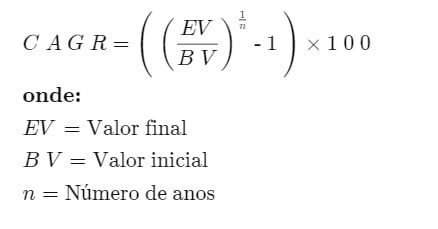 |
|
 |
|
 |
|
 |
|
 |
|
 |
|
 |
|
 |
|
 |
|
 |
|
 |
|
 |
|
 |
|
 |
|
 |
|
CAGR(복리연간성장률)CAGR은 연간 복리 수익률의 효과를 고려하여 특정 기간 동안 투자가 초기 가치에서 최종 가치로 성장하는 데 필요한 일정한 수익률을 나타내는 지표입니다. 이는 시간 경과에 따른 투자 성장률에 대한 단순화된 측정값을 제공하여 연간 수익률 변동에 관계없이 다양한 투자 간의 비교를 용이하게 합니다.

What is Compound Annual Growth Rate (CAGR)?
The Compound Annual Growth Rate represents o income necessary for an investment to evolve from its initial value to its final value, considering that the gains were reapplied at the end of each year of the investment period.
« 사전 색인으로 돌아가기 CAGR(복합 연간 성장률)이란 무엇입니까?연간 복합 성장률(CAGR)은 이익이 매년 말에 다시 적용된다는 점을 고려하여 투자가 초기 가치에서 최종 가치로 발전하는 데 필요한 소득을 나타냅니다. 투자기간.
How to Calculate Compound Annual Growth Rate (CAGR)
To determine the CAGR of an investment, follow the steps below:
CAGR(복합 연간 성장률)을 계산하는 방법 투자의 CAGR을 확인하려면 다음 단계를 따르세요.

- Calculate the ratio between the final value of the investment and its initial value.
- Raise this ratio to the power of one over the number of years in the period.
- Deduce one from the result found.
- Transform the final result into a percentage by multiplying it by 100.
Meaning of CAGR
Although CAGR does not reflect the true rate of return, it does offer a representative measure. It works as an index that indicates the speed at which an investment would have expanded if it had maintained a constant rate of annual growth, with income reinvested at the end of each year.
투자의 최종 가치와 초기 가치 사이의 비율을 계산합니다. 해당 기간의 연수에 대해 이 비율을 1의 거듭제곱으로 늘립니다. 찾은 결과에서 1을 뺍니다. 최종 결과에 다음을 곱하여 백분율로 변환합니다. 100.CAGRA의 의미 CAGR은 실제 수익률을 반영하지는 않지만 대표적인 지표를 제공합니다. 이는 매년 말에 소득을 재투자하여 일정한 연간 성장률을 유지했다면 투자가 확장되었을 속도를 나타내는 지표로 사용됩니다.
Due to actual annual performance variations, achieving this uniform growth is atypical. However, CAGR serves to level returns, making it easier to understand in contrast to other methods.
실제 연간 실적 변화로 인해 이러한 균일한 성장을 달성하는 것은 이례적입니다. 그러나 CAGR은 수익률을 평준화하는 역할을 하므로 다른 방법과 달리 이해하기 쉽습니다.
Practical example of using CAGR
Consider an initial investment of $10.000 in a portfolio that yielded the following returns:
CAGRConsider를 사용하여 포트폴리오에 $10,000의 초기 투자를 하여 다음과 같은 수익을 얻은 실제 예:
- From January 1, 2018 to January 1, 2019, the portfolio value increased to $13.000, representing 30% growth in the first year.
- As of January 1, 2020, the portfolio was worth $14.000, which is a 7,69% increase from January 2019 to January 2020.
- As of January 1, 2021, the final value was $19.000, marking 35,71% growth from January 2020 to January 2021.
The portfolio's annual returns varied significantly, depending on the percentages indicated. However, by applying CAGR, a unified view of investment performance is obtained, disregarding annual fluctuations. In this case, the CAGR for the three-year period was 23,86%, providing a simplified comparison basis for the investor to evaluate different resource allocation options or project future values.
2018년 1월 1일부터 2019년 1월 1일까지 포트폴리오 가치는 $13,000로 증가하여 첫 해에 30% 성장을 나타냈습니다. 2020년 1월 1일 현재 포트폴리오 가치는 $14,000로 1월보다 7,69% 증가했습니다. 2019년부터 2020년 1월까지. 2021년 1월 1일 현재 최종 가치는 $19,000로 2020년 1월부터 2021년 1월까지 35,71%의 성장을 기록했습니다. 포트폴리오의 연간 수익률은 표시된 백분율에 따라 크게 달라졌습니다. 그러나 CAGR을 적용하면 연간 변동을 무시하고 투자 성과에 대한 통일된 관점을 얻을 수 있습니다. 이 경우 3년 동안의 CAGR은 23,86%였으며, 이는 투자자가 다양한 자원 할당 옵션을 평가하거나 미래 가치를 예측할 수 있는 단순화된 비교 기반을 제공했습니다.
For example, when comparing two distinct investments, where one may appreciate while the other depreciates in a given year, as would be the case when comparing high-yield bonds with stocks or real estate investments with emerging markets, the CAGR helps to level out annual returns, simplifying the comparison between alternatives.
예를 들어, 고수익 채권과 주식을 비교하거나 부동산 투자와 신흥 시장을 비교할 때와 같이 특정 연도에 하나는 평가절상되고 다른 하나는 감가상각되는 두 개의 서로 다른 투자를 비교할 때 CAGR은 연간 수준을 유지하는 데 도움이 됩니다. 반환하여 대안 간의 비교를 단순화합니다.
Another example would be an investor who purchased 55 shares of Amazon.com in December 2017 for $1.180 each, for a total investment of $64.900. Three years later, in December 2020, the shares appreciated to $3.200 each, bringing the value of the investment to $176.000.
또 다른 예는 2017년 12월에 Amazon.com의 주식 55주를 주당 1.180달러에 구매하여 총 투자액이 64,900달러인 투자자입니다. 3년 후인 2020년 12월에 주가는 주당 3,200달러로 상승하여 투자 가치는 176,000달러가 되었습니다.
What is CAGR?
To understand CAGR, let’s consider a practical example with the following data:
CAGR이란 무엇입니까? CAGR을 이해하기 위해 다음 데이터의 실제 예를 고려해 보겠습니다.
- Final investment value: $176.000
- Initial investment value: $64.900
- Duration of investment: 3 years
Applying this information to the CAGR formula, we have:
최종 투자 가치: $176.000초기 투자 가치: $64.900투자 기간: 3년 이 정보를 CAGR 공식에 적용하면 다음과 같은 결과가 나옵니다.
[($176.000 / $64.900) ^ (1/3)] – 1 = 39,5%.Additional CAGR Applications
CAGR is useful in determining the average annual growth of an investment. This proves especially valuable in volatile market scenarios, where the return on an investment can vary significantly from year to year.
[($176.000 / $64.900) ^ (1/3)] – 1 = 39,5%. 추가 CAGR 응용 CAGR은 투자의 연평균 성장을 결정하는 데 유용합니다. 이는 투자 수익이 해마다 크게 달라질 수 있는 변동성이 큰 시장 시나리오에서 특히 유용하다는 것이 입증되었습니다.
For example, it may happen that an investment appreciates by 8% in one year, depreciates by 2% in the following year, and appreciates again by 5% in the following year. CAGR helps normalize returns, providing a more stable and understandable view of the growth trajectory, even when these rates are volatile and inconsistent.
예를 들어, 투자 가치가 1년에 8% 증가하고, 다음 해에 2% 감소하고, 다음 해에 다시 5% 증가하는 경우가 발생할 수 있습니다. CAGR은 수익률이 변동적이고 일관성이 없는 경우에도 성장 궤적에 대한 보다 안정적이고 이해하기 쉬운 관점을 제공하여 수익률을 표준화하는 데 도움이 됩니다.
Investment Comparison
CAGR provides a means of comparing the performance of different types of investments. Imagine an investor who, in 2015, invested $10.000 in a savings account with fixed annual interest of 1%, and an equal amount in a stock mutual fund, whose return tends to be more irregular over time.
투자 비교CAGR은 다양한 유형의 투자 성과를 비교하는 수단을 제공합니다. 2015년에 연간 고정 이자가 1%인 저축 계좌에 10,000달러를 투자하고 동일한 금액을 주식 뮤추얼 펀드에 투자했는데, 그 수익은 시간이 지남에 따라 더 불규칙해지는 경향이 있다고 상상해 보십시오.
At the end of five years, suppose the savings account has reached a balance of $10.510,10 and the stock fund, despite uneven growth, has reached $15.348,52. At first glance, the equity fund appears to be the most profitable investment, with a significantly higher return compared to the savings account.
5년 후에 저축 계좌의 잔액이 $10.510,10에 도달하고 주식 기금이 불균등한 성장에도 불구하고 $15.348,52에 도달했다고 가정해 보겠습니다. 언뜻 보기에 주식형 펀드는 저축예금에 비해 수익률이 훨씬 높아 가장 수익성이 높은 투자로 보입니다.
However, CAGR, by offering an average of returns, does not reveal the volatility or risk associated with the equity fund. Despite this limitation, CAGR can be incorporated into the MAR index, which adjusts results to risk, thus providing a more balanced analysis.
그러나 CAGR은 평균 수익률을 제공함으로써 주식형 펀드와 관련된 변동성이나 위험을 드러내지 않습니다. 이러한 제한에도 불구하고 CAGR은 MAR 지수에 통합되어 결과를 위험에 맞게 조정하여 보다 균형 잡힌 분석을 제공할 수 있습니다.
Performance Monitoring
CAGR is also applicable in monitoring the performance of different business aspects, whether of a single company or comparing several. For example, if the CAGR for big-box market share is 1,82% over five years, while the CAGR for customer satisfaction is -0,58% over the same period, this comparison reveals valuable insights into the strengths and weaknesses of the company.
Performance MonitoringCAGR은 단일 회사이든 여러 회사를 비교하든 다양한 비즈니스 측면의 성과를 모니터링하는 데에도 적용할 수 있습니다. 예를 들어, 대형 박스 시장 점유율에 대한 CAGR이 5년 동안 1,82%인 반면, 고객 만족도에 대한 CAGR은 같은 기간에 -0,58%인 경우, 이 비교는 해당 제품의 강점과 약점에 대한 귀중한 통찰력을 보여줍니다. 회사.
Assessment of Strengths and Weaknesses
Analyzing the CAGRs of competing companies' business operations offers an effective means of identifying relative advantages and disadvantages. A clear example of this can be seen when comparing Big-Sale's customer satisfaction CAGR with that of SuperFast Cable, which recorded a customer satisfaction CAGR of -6,31% in the same time frame. Such a comparison allows a detailed assessment of the strengths and weaknesses between competitors.
강점과 약점 평가경쟁 기업의 사업 운영에 대한 CAGR을 분석하는 것은 상대적인 장점과 단점을 식별하는 효과적인 수단을 제공합니다. Big-Sale의 고객 만족도 CAGR을 같은 기간에 -6.31%의 고객 만족도 CAGR을 기록한 SuperFast Cable의 고객 만족도 CAGR과 비교할 때 이에 대한 명확한 예를 볼 수 있습니다. 이러한 비교를 통해 경쟁사 간의 강점과 약점을 자세히 평가할 수 있습니다.
Use of CAGR by Investors
Mastering the CAGR formula opens the door to several other applications used by investors to analyze past returns and project future profits. Algebraic manipulation of the CAGR formula can make it easier to calculate the present or future value of money, or determine a minimum required rate of return.
투자자의 CAGR 사용 CAGR 공식을 익히면 투자자가 과거 수익을 분석하고 미래 이익을 예측하는 데 사용하는 여러 다른 응용 프로그램에 대한 문이 열립니다. CAGR 공식을 대수적으로 조작하면 현재 또는 미래의 화폐 가치를 계산하거나 최소 요구 수익률을 결정하는 것이 더 쉬워집니다.
Consider, for example, an investor who needs to accumulate US$50.000 for a child's college education in 18 years, currently having US$15.000 to invest. To calculate the average rate of return necessary to achieve this objective, one can resort to calculating the CAGR, adapting the formula to find the required rate.
예를 들어, 자녀의 대학 교육을 위해 18년 동안 미화 50,000달러를 축적해야 하고 현재 투자할 수 있는 금액이 미화 15,000달러인 투자자가 있다고 가정해 보겠습니다. 이 목표를 달성하는 데 필요한 평균 수익률을 계산하려면 CAGR을 계산하고 공식을 적용하여 필요한 수익률을 찾을 수 있습니다.
This adaptation is nothing more than a rearranged version of the present value and future value equations. If an investor aims to achieve an amount of $50.000, assuming an expected annual return of 8% on the investment, he can use this version of the CAGR formula to calculate the initial amount needed to reach his goal.
이러한 적응은 현재 가치와 미래 가치 방정식을 재배열한 것에 지나지 않습니다. 투자자가 투자에 대한 연간 기대 수익률을 8%로 가정하고 $50,000의 금액 달성을 목표로 하는 경우 이 버전의 CAGR 공식을 사용하여 목표 달성에 필요한 초기 금액을 계산할 수 있습니다.
Adjustments to the CAGR Formula
Investments are rarely made precisely at the beginning and sold precisely at the end of a calendar year. Suppose an investor wants to calculate the CAGR of an investment of US$10.000 made on June 1, 2013 and settled for US$16.897,14 on September 9, 2018.
CAGR FormulaInvestments에 대한 조정은 처음에 정확하게 이루어지지 않고 달력 연도 말에 정확히 판매됩니다. 투자자가 2013년 6월 1일에 투자한 US$10,000에 대한 CAGR을 계산하고 2018년 9월 9일에 US$16,897,14에 결제했다고 가정해 보겠습니다.
To calculate the CAGR, it is initially necessary to determine the exact fraction of the investment period. The investment lasted 213 days in 2013, followed by full years until 2017, and a further 251 days in 2018, totaling an investment period of approximately 5,271 years, calculated as follows:
CAGR을 계산하려면 먼저 투자 기간의 정확한 부분을 결정해야 합니다. 투자 기간은 2013년 213일, 2017년까지 1년, 2018년에는 251일로 총 투자 기간은 약 5,271년으로, 다음과 같이 계산됩니다.
- 2013: 213 days
- 2014 to 2017: 365 days each year
- 2018: 251 days
The total number of days on which the investment was maintained totals 1.924. Dividing this total by 365, we obtain 5,271 years, the total duration of the investment.
2013년 : 213일 2014년 ~ 2017년 : 매년 365일 2018년 : 251일 총 투자유지일수는 1.924일입니다. 이 합계를 365로 나누면 총 투자 기간인 5,271년이 됩니다.
This exact period, expressed in years, is then applied to the denominator of the exponent in the CAGR formula to obtain the adjusted calculation.
연도 단위로 표시되는 이 정확한 기간은 CAGR 공식의 지수 분모에 적용되어 조정된 계산을 얻습니다.
Moderation in Growth Rate with CAGR
The main restriction of CAGR lies in the fact that it calculates a moderate rate of growth over a specific period, disregarding volatility and assuming constant growth during that time. This contrasts with the reality of investments, whose returns tend to vary significantly, except for fixed income investments such as held-to-maturity bonds or bank deposits.
CAGR을 통한 성장률 조절 CAGR의 주요 제한 사항은 변동성을 무시하고 해당 기간 동안 지속적인 성장을 가정하여 특정 기간 동안 적당한 성장률을 계산한다는 사실에 있습니다. 이는 만기보유채권이나 은행예금 등 채권투자를 제외하면 수익률이 크게 달라지는 투자의 현실과 대조된다.
Additionally, the CAGR does not take into account any contributions or withdrawals of resources by the investor in their portfolio during the period analyzed. For example, if an investor were to make additional contributions to the portfolio over five years, the resulting CAGR could be overestimated. The formula calculates the rate of return based on the initial and final values during the five-year period, unduly considering contributions as part of annual growth, which distorts reality.
또한 CAGR은 분석 기간 동안 투자자가 포트폴리오에 투자하거나 자원을 인출하는 것을 고려하지 않습니다. 예를 들어, 투자자가 5년 동안 포트폴리오에 추가 기여를 한다면 결과 CAGR이 과대평가될 수 있습니다. 5년간의 초기값과 최종값을 기준으로 수익률을 계산하는 공식은 기여금을 연간 성장의 일부로 부당하게 간주해 현실을 왜곡한다.
Other Limitations of CAGR
In addition to its growth smoothing characteristic, CAGR has other limitations. One of them is the impossibility of guaranteeing the continuity of past performance in the future. The reliability of the CAGR decreases the shorter the period considered for the analysis, reducing the chances that the projected CAGR corresponds to that actually realized, based on historical data.
CAGR의 기타 제한 사항 CAGR에는 성장 평활화 특성 외에도 다른 제한 사항이 있습니다. 그 중 하나는 과거 성과의 미래 연속성을 보장하는 것이 불가능하다는 점이다. CAGR의 신뢰성은 분석에 고려되는 기간이 짧을수록 감소하며, 예상 CAGR이 과거 데이터를 기반으로 실제로 실현된 CAGR과 일치할 가능성이 줄어듭니다.
Another limitation concerns its representativeness. Considering an investment fund that was worth $100.000 in 2016, fell to $71.000 in 2017, declined further to $44.000 in 2018, rose to $81.000 in 2019, and reached $126.000 in 2020. If, in 2021, it were disclosed that the fund's CAGR over the past three years was a significant 42,01%, the information would be technically correct. However, it would be omitting crucial aspects of the fund's trajectory, such as the modest 4,73% rate over five years.
또 다른 한계는 대표성에 관한 것이다. 2016년 $100,000의 가치가 있었던 투자 펀드를 고려하면, 2017년에는 $71,000로 떨어졌고, 2018년에는 $44,000로 더 하락했고, 2019년에는 $81,000로 상승했으며, 2020년에는 $126,000에 도달했습니다. 2021년에 해당 펀드의 CAGR이 지난 3년간의 비중이 42,01%로 상당했다면 해당 정보는 기술적으로 정확할 것입니다. 그러나 이는 5년간 4,73%의 적당한 금리와 같은 펀드 궤도의 중요한 측면을 생략하는 것입니다.
CAGR vs. IRR
While CAGR offers a measure of an investment's return over a given period, Internal Rate of Return (IRR) provides a more comprehensive view of investment performance and is more versatile than CAGR.
CAGR 대 IRRCAGR이 특정 기간 동안 투자 수익률을 측정하는 반면, IRR(내부 수익률)은 투자 성과에 대한 보다 포괄적인 보기를 제공하며 CAGR보다 더 다양합니다.
The main distinction between the two lies in the simplicity of CAGR, which allows for manual calculation. On the other hand, for more complex investments or projects, with multiple inflow and outflow transactions, the IRR is more appropriate. Determining the IRR generally requires the use of a financial calculator, spreadsheets such as Excel, or specialized portfolio management systems.
둘 사이의 주요 차이점은 수동 계산이 가능한 CAGR의 단순성에 있습니다. 반면, 유입 및 유출 거래가 여러 개인 보다 복잡한 투자나 프로젝트의 경우 IRR이 더 적합합니다. IRR을 결정하려면 일반적으로 재무 계산기, Excel과 같은 스프레드시트 또는 전문 포트폴리오 관리 시스템을 사용해야 합니다.
Individuals interested in deepening their knowledge of CAGR and other financial topics can benefit from exploring some of the best investment courses available on the market today.
CAGR 및 기타 금융 주제에 대한 지식을 심화하는 데 관심이 있는 개인은 현재 시장에서 제공되는 최고의 투자 과정을 탐색하여 혜택을 누릴 수 있습니다.
Conclusion
The Compound Annual Growth Rate (CAGR) emerges as a fundamental analytical tool for investors and financial analysts, providing a clear, composite view of an investment's growth over time. When considering the effect of compounding, CAGR provides a smoothed and consistent measure that can be compared across different investment options, regardless of annual fluctuations.
결론 CAGR(복합 연간 성장률)은 투자자와 재무 분석가를 위한 기본 분석 도구로 등장하여 시간 경과에 따른 투자 성장에 대한 명확하고 종합적인 관점을 제공합니다. 복리 효과를 고려할 때 CAGR은 연간 변동에 관계없이 다양한 투자 옵션을 비교할 수 있는 원활하고 일관된 측정값을 제공합니다.
While CAGR offers numerous advantages, such as the ability to level out the volatility of returns and provide a long-term perspective on growth, it is not without limitations. Its smoothing approach can hide periods of underperformance and does not account for capital movements during the analysis period, such as contributions or withdrawals. Furthermore, CAGR's effectiveness as an indicator of future financial performance is limited, as it cannot predict changes in market conditions or a company's management.
CAGR은 수익률의 변동성을 평준화하고 성장에 대한 장기적인 관점을 제공하는 능력과 같은 수많은 이점을 제공하지만 한계가 없는 것은 아닙니다. 평활화 접근 방식은 실적이 저조한 기간을 숨길 수 있으며 분석 기간 동안 기부 또는 인출과 같은 자본 이동을 설명하지 않습니다. 더욱이 CAGR은 시장 상황이나 기업 경영의 변화를 예측할 수 없기 때문에 미래 재무 성과를 나타내는 지표로서의 효율성에는 한계가 있습니다.
The distinction between CAGR and other metrics, such as Internal Rate of Return (IRR) and simple growth rates, highlights the importance of selecting the most appropriate analysis tool for each specific situation. By adjusting CAGR for risk factors, investors can obtain a more accurate assessment of the risk-adjusted performance of their investments.
CAGR과 내부 수익률(IRR) 및 단순 성장률과 같은 기타 지표 간의 차이는 각 특정 상황에 가장 적합한 분석 도구를 선택하는 것의 중요성을 강조합니다. 위험 요소에 대한 CAGR을 조정함으로써 투자자는 투자의 위험 조정 성과에 대해 보다 정확한 평가를 얻을 수 있습니다.
FAQ
What is an example of a Compound Annual Growth Rate (CAGR)?
CAGR is a key indicator used by investors to analyze the evolution of the value of an investment over time. The inclusion of the word “compound” reflects CAGR's ability to incorporate the effect of capitalization, that is, the reinvestment of earnings over a period. Imagine, for example, that a company saw an increase in revenue from $3 million to $30 million in ten years. In this case, the CAGR would be around 25,89%.
FAQCAGR(복합 연간 성장률)의 예는 무엇입니까? CAGR은 투자자가 시간에 따른 투자 가치의 변화를 분석하기 위해 사용하는 핵심 지표입니다. "복합"이라는 단어가 포함된 것은 자본화 효과, 즉 일정 기간 동안의 수익 재투자를 통합하는 CAGR의 능력을 반영합니다. 예를 들어, 한 회사의 수익이 10년 만에 3백만 달러에서 3천만 달러로 증가했다고 상상해 보세요. 이 경우 CAGR은 약 25,89%입니다.
What constitutes a good CAGR?
A “good” CAGR varies depending on the specific context, including factors such as opportunity cost and risk associated with the investment. For example, an annual growth rate of 25% could be considered modest in an industry where the average is 30%, but impressive in a market where the average is 10% to 15%. Generally speaking, a higher CAGR is preferable.
좋은 CAGR을 구성하는 것은 무엇입니까? "좋은" CAGR은 기회 비용 및 투자와 관련된 위험과 같은 요소를 포함하여 특정 상황에 따라 달라집니다. 예를 들어, 연간 성장률 25%는 평균이 30%인 산업에서는 적당한 것으로 간주될 수 있지만 평균이 10~15%인 시장에서는 인상적입니다. 일반적으로 CAGR이 높을수록 좋습니다.
Difference between CAGR and Growth Rate
The main distinction between CAGR and a simple growth rate lies in the fact that CAGR assumes a constant, annually compounded growth rate, whereas a standard growth rate assumes no such constancy. CAGR is often preferred by investors for its ability to even out fluctuations in growth rates from year to year, providing a more stable view of a company's growth over time, even if there are years of lower performance.
CAGR과 성장률의 차이 CAGR과 단순 성장률의 주요 차이점은 CAGR이 일정한 연간 복합 성장률을 가정하는 반면 표준 성장률은 그러한 불변성을 가정하지 않는다는 사실에 있습니다. CAGR은 해마다 성장률의 변동을 균등화할 수 있는 능력으로 인해 투자자들이 선호하는 경우가 많으며, 수년간 실적이 저조하더라도 시간이 지남에 따라 회사의 성장에 대한 보다 안정적인 보기를 제공합니다.
Can CAGR be negative?
Yes, it is possible for the CAGR to be negative, which indicates a reduction in the value of the investment over the analyzed period, rather than an increase.
CAGR이 음수일 수 있습니까?예, CAGR이 음수일 수 있습니다. 이는 분석 기간 동안 투자 가치의 증가가 아니라 감소를 나타냅니다.
What does risk adjusted CAGR mean?
Investors looking to evaluate the performance of different investment options considering both returns and associated risks can turn to risk-adjusted CAGR. This calculation is performed by multiplying the CAGR by (1 – the standard deviation of the return on investment). If the standard deviation is zero, the risk-adjusted CAGR will be the same as the unadjusted CAGR. However, a higher standard deviation results in a lower risk-adjusted CAGR, reflecting the increased risk.
위험 조정 CAGR은 무엇을 의미합니까?수익률과 관련 위험을 모두 고려하여 다양한 투자 옵션의 성과를 평가하려는 투자자는 위험 조정 CAGR로 전환할 수 있습니다. 이 계산은 CAGR에 (1 – 투자 수익의 표준 편차)를 곱하여 수행됩니다. 표준 편차가 0이면 위험 조정 CAGR은 조정되지 않은 CAGR과 동일합니다. 그러나 표준 편차가 높을수록 위험 조정 CAGR이 낮아져 위험 증가를 반영합니다.
카테고리: 블록체인 사전« 사전 색인으로 돌아가기
부인 성명:info@kdj.com
제공된 정보는 거래 조언이 아닙니다. kdj.com은 이 기사에 제공된 정보를 기반으로 이루어진 투자에 대해 어떠한 책임도 지지 않습니다. 암호화폐는 변동성이 매우 높으므로 철저한 조사 후 신중하게 투자하는 것이 좋습니다!
본 웹사이트에 사용된 내용이 귀하의 저작권을 침해한다고 판단되는 경우, 즉시 당사(info@kdj.com)로 연락주시면 즉시 삭제하도록 하겠습니다.
-

-

-

-

-

-

-

-

- 여성은 비트 코인 혁명의 핵심 선수입니다.
- 2025-03-09 08:50:45
- 이번 주 현재 우리는 비트 코인이 적어도 부분적으로 인수 한 새로운 경제에 참여하고 있습니다.
-





























































